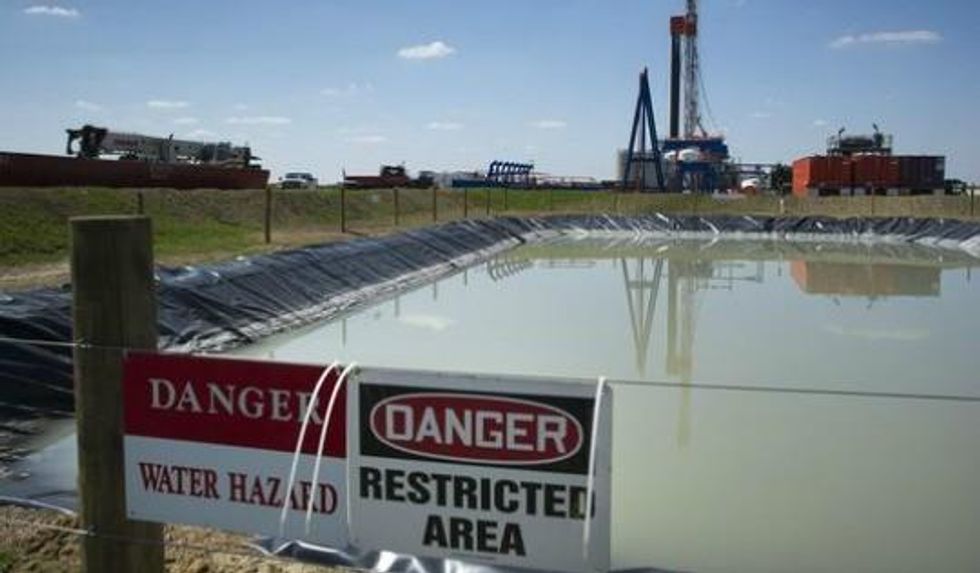Radioactive Water Streaming Out of Pennsylvania Fracking Waste Site
Report reveals 'surprising magnitude of radioactivity' in local water sources from fracking waste

"We were surprised by the magnitude of radioactivity" downstream from the plant, said co-author Avner Vengosh, geochemistry professor at Duke's Nicholas School of the Environment. "It's unusual to find this level," he told USA Today, adding that other sites should be investigated.
The Guardian reports:
The Duke University study, published on Wednesday, examined the water discharged from Josephine Brine Treatment Facility into Blacklick Creek, which feeds into a water source for western Pennsylvania cities, including Pittsburgh. Scientists took samples upstream and downstream from the treatment facility over a two-year period, with the last sample taken in June this year.
Elevated levels of chloride and bromide, combined with strontium, radium, oxygen, and hydrogen isotopic compositions, are present in the Marcellus shale waste waters, the study found.
The report, published in the journal Environmental Science & Technology by a group of Duke University researchers, states that fracking waste water disposal methods pose a great threat to human and environmental health, particularly gas companies that send waste to treatment sites that are currently allowed to release treated water into local streams.
Shale gas production, i.e. fracking, is currently exempt from certain rules within laws such as the Clean Water Act and the Safe Water Drinking Act due to the "Halliburton loophole" pushed through by former Vice-President/former Halliburton CEO Dick Cheney. Frackers are allowed to monitor their own waste production and largely avoid any regulated restrictions.
According to the researchers, radium levels in the Pennsylvania stream sediments where waste-water was discharged were about "200 times greater than upstream and background sediments and above radioactive waste disposal threshold regulations, posing potential environmental risks of radium bio-accumulation in localized areas of shale gas waste-water disposal."
"Each day, oil and gas producers generate 2 billion gallons of waste-water," said co-author Robert B. Jackson, Duke professor of environmental science, Tuesday. "They produce more waste-water than hydrocarbons. That's the broader implication of this study. We have to do something with this waste-water."
"The use of fossil fuels has a direct climate connection," he said. "Hundreds of billions of gallons of waste-water is a consequence of our reliance -- our addiction -- to fossil fuels. That's another price we pay for needing so much oil and gas."
_______________________
An Urgent Message From Our Co-Founder
Dear Common Dreams reader, The U.S. is on a fast track to authoritarianism like nothing I've ever seen. Meanwhile, corporate news outlets are utterly capitulating to Trump, twisting their coverage to avoid drawing his ire while lining up to stuff cash in his pockets. That's why I believe that Common Dreams is doing the best and most consequential reporting that we've ever done. Our small but mighty team is a progressive reporting powerhouse, covering the news every day that the corporate media never will. Our mission has always been simple: To inform. To inspire. And to ignite change for the common good. Now here's the key piece that I want all our readers to understand: None of this would be possible without your financial support. That's not just some fundraising cliche. It's the absolute and literal truth. We don't accept corporate advertising and never will. We don't have a paywall because we don't think people should be blocked from critical news based on their ability to pay. Everything we do is funded by the donations of readers like you. Will you donate now to help power the nonprofit, independent reporting of Common Dreams? Thank you for being a vital member of our community. Together, we can keep independent journalism alive when it’s needed most. - Craig Brown, Co-founder |
Jacob Chamberlain is a former staff writer for Common Dreams. He is the author of Migrant Justice in the Age of Removal. His website is www.jacobpchamberlain.com.

"We were surprised by the magnitude of radioactivity" downstream from the plant, said co-author Avner Vengosh, geochemistry professor at Duke's Nicholas School of the Environment. "It's unusual to find this level," he told USA Today, adding that other sites should be investigated.
The Guardian reports:
The Duke University study, published on Wednesday, examined the water discharged from Josephine Brine Treatment Facility into Blacklick Creek, which feeds into a water source for western Pennsylvania cities, including Pittsburgh. Scientists took samples upstream and downstream from the treatment facility over a two-year period, with the last sample taken in June this year.
Elevated levels of chloride and bromide, combined with strontium, radium, oxygen, and hydrogen isotopic compositions, are present in the Marcellus shale waste waters, the study found.
The report, published in the journal Environmental Science & Technology by a group of Duke University researchers, states that fracking waste water disposal methods pose a great threat to human and environmental health, particularly gas companies that send waste to treatment sites that are currently allowed to release treated water into local streams.
Shale gas production, i.e. fracking, is currently exempt from certain rules within laws such as the Clean Water Act and the Safe Water Drinking Act due to the "Halliburton loophole" pushed through by former Vice-President/former Halliburton CEO Dick Cheney. Frackers are allowed to monitor their own waste production and largely avoid any regulated restrictions.
According to the researchers, radium levels in the Pennsylvania stream sediments where waste-water was discharged were about "200 times greater than upstream and background sediments and above radioactive waste disposal threshold regulations, posing potential environmental risks of radium bio-accumulation in localized areas of shale gas waste-water disposal."
"Each day, oil and gas producers generate 2 billion gallons of waste-water," said co-author Robert B. Jackson, Duke professor of environmental science, Tuesday. "They produce more waste-water than hydrocarbons. That's the broader implication of this study. We have to do something with this waste-water."
"The use of fossil fuels has a direct climate connection," he said. "Hundreds of billions of gallons of waste-water is a consequence of our reliance -- our addiction -- to fossil fuels. That's another price we pay for needing so much oil and gas."
_______________________
Jacob Chamberlain is a former staff writer for Common Dreams. He is the author of Migrant Justice in the Age of Removal. His website is www.jacobpchamberlain.com.

"We were surprised by the magnitude of radioactivity" downstream from the plant, said co-author Avner Vengosh, geochemistry professor at Duke's Nicholas School of the Environment. "It's unusual to find this level," he told USA Today, adding that other sites should be investigated.
The Guardian reports:
The Duke University study, published on Wednesday, examined the water discharged from Josephine Brine Treatment Facility into Blacklick Creek, which feeds into a water source for western Pennsylvania cities, including Pittsburgh. Scientists took samples upstream and downstream from the treatment facility over a two-year period, with the last sample taken in June this year.
Elevated levels of chloride and bromide, combined with strontium, radium, oxygen, and hydrogen isotopic compositions, are present in the Marcellus shale waste waters, the study found.
The report, published in the journal Environmental Science & Technology by a group of Duke University researchers, states that fracking waste water disposal methods pose a great threat to human and environmental health, particularly gas companies that send waste to treatment sites that are currently allowed to release treated water into local streams.
Shale gas production, i.e. fracking, is currently exempt from certain rules within laws such as the Clean Water Act and the Safe Water Drinking Act due to the "Halliburton loophole" pushed through by former Vice-President/former Halliburton CEO Dick Cheney. Frackers are allowed to monitor their own waste production and largely avoid any regulated restrictions.
According to the researchers, radium levels in the Pennsylvania stream sediments where waste-water was discharged were about "200 times greater than upstream and background sediments and above radioactive waste disposal threshold regulations, posing potential environmental risks of radium bio-accumulation in localized areas of shale gas waste-water disposal."
"Each day, oil and gas producers generate 2 billion gallons of waste-water," said co-author Robert B. Jackson, Duke professor of environmental science, Tuesday. "They produce more waste-water than hydrocarbons. That's the broader implication of this study. We have to do something with this waste-water."
"The use of fossil fuels has a direct climate connection," he said. "Hundreds of billions of gallons of waste-water is a consequence of our reliance -- our addiction -- to fossil fuels. That's another price we pay for needing so much oil and gas."
_______________________

